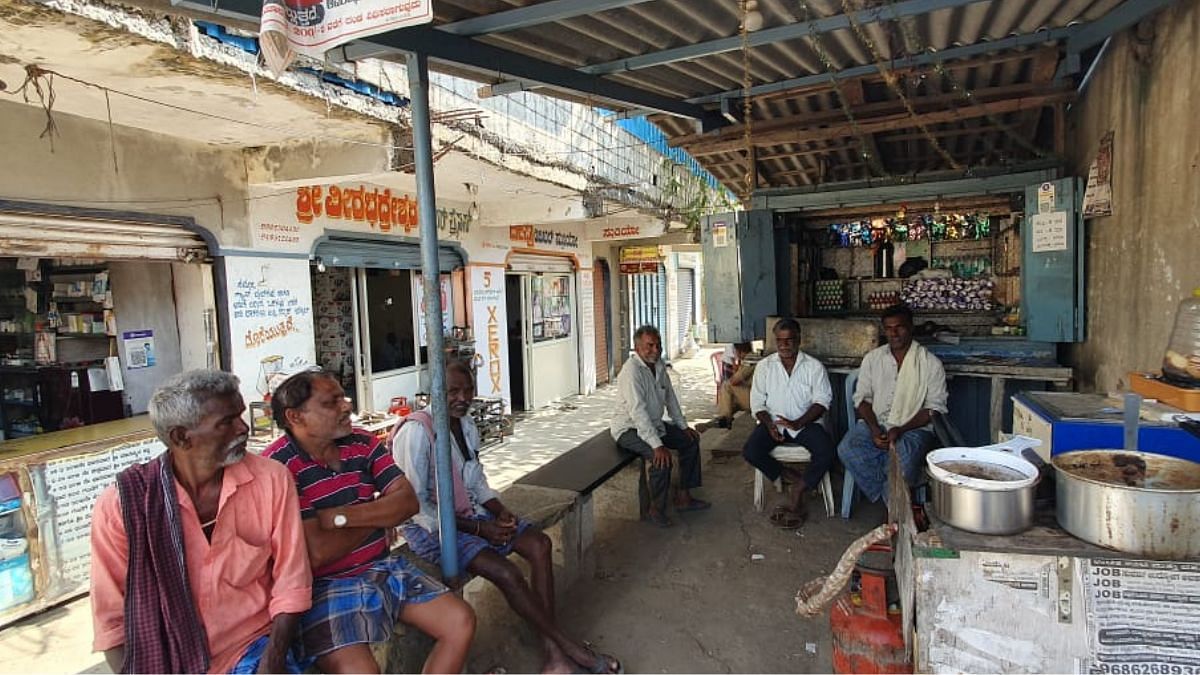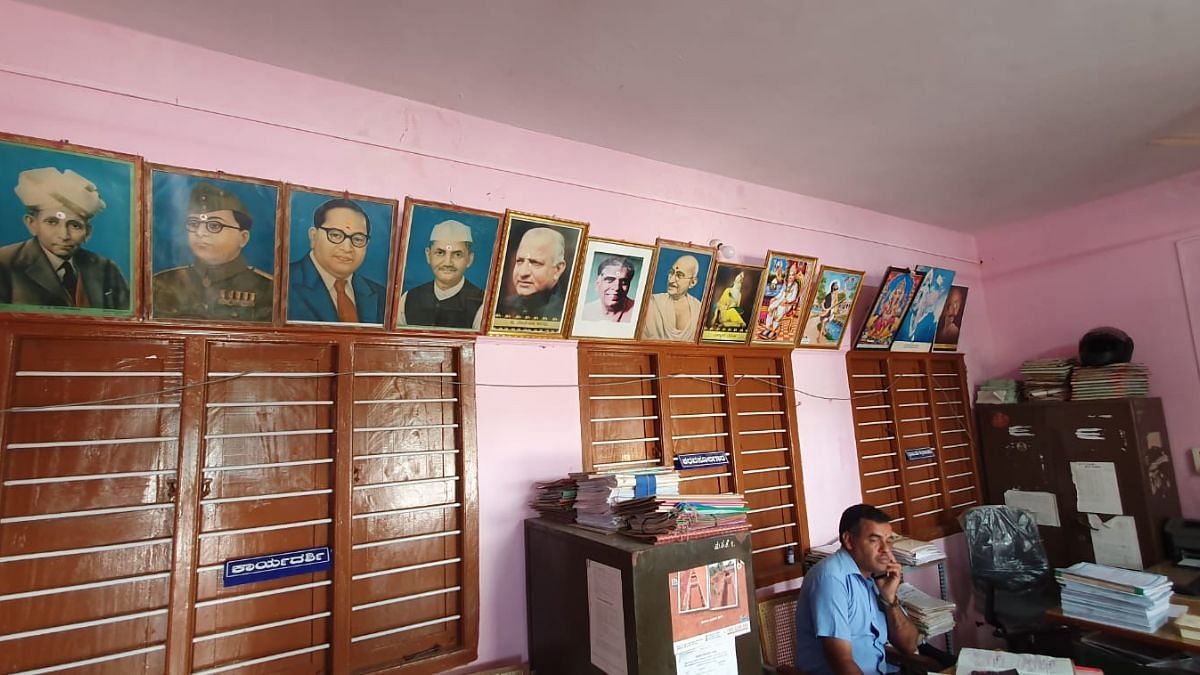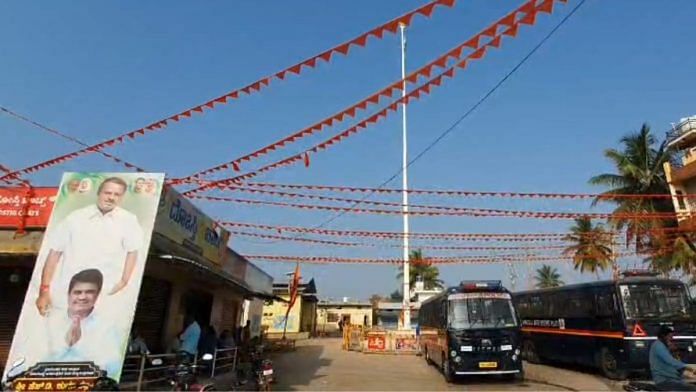Keragodu (Mandya): It was around 5 am Wednesday when a family in Mandya’s Keragodu village woke up to loud knocks on their front door. Waiting outside were police personnel looking for their 14-year-old son, Yeshwant.
“They asked me to go with them (police) and assured my family that they will not harm me,” Yeshwant told ThePrint. “They told me that the inspector was asking for me and all they wanted was a signature.”
Yeshwant, a Class 9 student, was taken to the police station amid suspicions that he was among the youngsters involved in stone-pelting that took place near his home on 28 January.
While Yeshwant was indeed let off later the same day, Keragodu remains shaken by what is seen as an unprecedented episode of tensions in their calm village.
At the centre of the tensions is a flag pole, and the decision of the local authorities to remove a Hanuman flag hoisted there Sunday, while allegedly using force to disperse a protest by villagers and members of Hindutva groups gathered there.
The villagers say hoisting religious flags — from those hailing Hanuman to ones bearing the ‘Om’ symbol — has been a tradition dating back over three decades. However, the panchayat development officer (PDO) is believed to have ordered the flag to be brought down after Republic Day, on the grounds that the post is on government land.
In the Congress-led state, the matter soon created a larger ripple-effect.
On Wednesday, local BJP leaders and members of Hindutva groups visited Yeshwant’s home and assured him of support.
In a protest a day earlier, former chief minister H.D. Kumaraswamy of the Janata Dal (Secular) wore a saffron shawl and stood shoulder-to-shoulder with members of ally BJP, accusing the Congress of being anti-Hindu.
Meanwhile, the Mandya MLA, a Congress leader, has alleged an “RSS ploy” behind the tensions, with Chief Minister Siddaramaiah also blaming the BJP for the controversy and saying the national flag should be hoisted on the post.
The BJP has called for a Mandya bandh on 9 February, while another section has called a bandh two days before.
Also Read: Rich Muslims, angry Hindus: Why coastal Karnataka and Kerala are hotbeds of violent politics
‘Never seen such scenes’
Keragodu is a nondescript village located about 12 km from the ‘sugar city’ of Mandya. According to the 2011 census, this district has a population of over 1.8 million, with Hindus accounting for over 94 percent and Muslims just 4.31 percent.
Local folklore suggests that its name comes from an episode that took place several centuries ago, involving a thirsty man who approached a local resident seeking water. The villager, it is believed, told the man to run to the two lakes nearby instead.
In Kannada, lake is ‘kere’, and run is ‘odu’.
“I asked for water and he is asking me to run to the lake,” the man is believed to have told some people, and “Keragodu” stuck as the name of the village.
When ThePrint visited earlier this week, the roads in the village were lined with saffron flags, most of them up since the 22 January pran pratishtha ceremony in Ayodhya.
Around the flag post — towering at 108 feet, and equipped with an electric hoisting mechanism — at least 100 police personnel sat in vigil, a circle of barricades placed around to prevent anyone else from getting close.
At a tea stall near Yeshwant’s residence, 57-year-old Krishna Gowda sat chatting with older friends.
“In all my years, I haven’t seen these kinds of scenes,” he said. “Have you?” he asked Shivaraju, eight years his senior.

Residents say the practice of hoisting flags in the village — saffron ones on most days, and the national and state flags on three occasions — Independence Day, Republic Day and Karnataka Rajyotsava — can be traced back to 35 years ago, when a slim trunk of an areca nut tree was installed as a flag post.
Incumbent Chief Minister Siddaramaiah, then the animal husbandry minister, was present at the inauguration of the flag post, they add.
“Siddaramaiah was a minister in Ramakrishna Hegde’s government. He was a local leader and came for the inauguration,” said Anand Tagadugowda, a retired PT master and member of the gram panchayat. “But he had unfurled the Karnataka flag that day.”
Over the years, this flag post made way for another — 20 feet tall, and made of metal — before the current one was erected ahead of the Ayodhya event.
It was a group of youngsters who reportedly came up with the idea of installing a new, taller pole for the ceremony. When they approached the panchayat, they were asked to get a letter from a registered organisation. The Gouri Shankar Trust, a local organisation of which Tagadugowda is a founding member, stepped in to offer that.
The youngsters then began a donation drive and, within a month, installed the new post, which came with a key to secure its hoisting mechanism, at a cost of around Rs 9 lakh, villagers say.
Between November and 25 January, local residents add, the Gram Panchayat held three meetings but the Panchayat Development Officer (PDO), present in these meetings, had registered his objections to hoisting the saffron flag.
According to the proceedings of these meetings, accessed by ThePrint, in the second week of January, 18 of the 21 gram panchayat members backed the idea to hoist a saffron flag on the flag post, but the local PDO did not sign off on the decision, saying that the post stands on government land.
Speaking to ThePrint, the local Congress MLA, Ravikumar Ganiga, said there were at least five groups and organisations that objected to the idea of a saffron flag. These groups demanded the right to hoist flags representing other ideologies since the post was on government land.
What happened that day
On 22 January, a saffron flag was hoisted which was replaced with the Tricolour for Republic Day.
Later that same day, the national flag was brought down — as warranted by the flag code — and replaced with the Hanuman flag. The PDO and the local police held conciliatory meetings with the villagers, informing them that permission was given only to hoist the national and state flags.
Villagers convinced him that it would be brought down in a day. When the local executive officer (EO), a government official at the Taluk level, came to the spot and asked that the flag be brought down, the villagers resisted.
“She gave us three days and left. But the same night we heard that the EO had complained to the district administration and was coming with police protection,” Tagadugowda said.
Villagers, it is learnt, got wind of the plans and gathered around the flag post around midnight. The police arrived in batches at around 3 am, and tried to convince the villagers to bring down the flag before proceeding to do so themselves, villagers say.
As it was being brought down, the police allegedly tried to push back protesting villagers and a scuffle ensued.
When the flag was finally being brought down, an unknown person is said to have taken away the key and the electric wire of the hoisting mechanism, which further fuelled tensions.
“By the time the police could manage to get the key, it was around 3 pm and the police had already used lathicharge to disperse the crowd,” Tagadugowda said.
BJP leader R. Ashok, in Mandya for another programme, came to Keragodu as soon as he learnt of the situation. In a hurry, villagers say, police personnel hoisted the first national flag they could get their hands on.
A 3-foot-wide national flag is currently hoisted atop the post.
“The situation in the village is calm and everything is peaceful. We are engaging with the locals to resolve this amicably,” a senior police official said, requesting anonymity.
Also Read: ‘Riots, hate, killings’ — how this Karnataka district became hotbed of Hindu-Muslim violence
‘Unfurl any flag you want’
Mandya is at the heart of Karnataka’s Vokkaliga politics — the Gowdas of the Janata Dal (Secular) hail from this community.
The flag incident comes around two years after Hindutva groups, including the Vishva Hindu Parishad called for a march to a mosque at Srirangapatna, about 25 km from Keragodu, alleging that it is built on the ruins of a temple.
With no known history of communal and caste-related tension in Keragodu, everyone has a different theory about the current spate of tensions.
Shivaraju, 65, said the current controversy “is all a ploy of the Congress government”. “Every time they come to power, there is some sort of communal tension,” he added.
A local auto driver said a JD(S) leader was called to inaugurate the new flag pole, and it angered the Congress MLA, who “is behind the entire conspiracy”.
MLA Ravikumar Ganiga meanwhile said the “RSS is trying to convert our village into Karavali (coastal districts of Karnataka, known to be communally sensitive)”.
“Our villagers are innocent souls and the RSS is trying to exploit them to create a base here,” Ganiga told ThePrint.
A police constable, requesting anonymity, said it was Keragodu’s history of peace that prevented the situation from spiralling out of control. “If this incident (flag) had happened in any of the neighbouring villages, there would have been a bloodbath,” the constable added.

Meanwhile, back at Yeshwant’s home, the issue of the flag has taken the backseat to more immediate concerns. Yeshwant’s father Rajesh has been unable to open his shop, the family’s sole source of income, since Sunday due to the heavy police presence and tense atmosphere.
“Go unfurl any flag you want,” he told the BJP leaders and media persons who came to meet the family earlier this week. “I don’t have anything to do with it.”
At the flag post, accompanying the police personnel sitting around the flag are panchayat members, who too keep vigil in turns.
“I have other work but if I don’t spend time sitting here (around the flag), I will be accused of abandoning our cause and assert our right to unfurl the saffron flag,” Shivananda, a member of the panchayat, said.
(Edited by Sunanda Ranjan)
Also Read: As communal tensions rise in Karnataka, IT firms ‘reach out’ to investment-seeking Tamil Nadu



